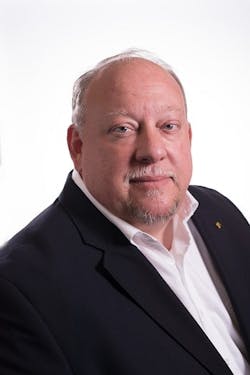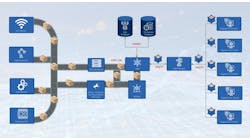Kevin McMillen was promoted to head Yokogawa’s North American business as president and CEO. McMillen will strategically align efforts to drive a stronger sustainability focus, working with a range of industries toward the company’s goals of achieving net-zero emissions, ensuring well-being of people and transitioning to a circular economy.
McMillen brings experience in industrial automation, control and digital transformation to further develop Yokogawa’s 60-year-old North American business with a look to the future and a commitment toward placing equal focus on our planet, people and profit.
"The energy transition is challenging the relevance of many industries and driving many businesses to re-evaluate their strategies in alignment with the direction of society and emerging technologies,” says McMillen. “Yokogawa is committed to supporting a much-needed transition across all forms of energy production to a more sustainable landscape, enabling a higher quality of life for our present and future societies."
Since 2016, McMillen served as vice president of system sales for North America. He received his B.B.A. in management and accounting from Marshall University.
What are three key things that a machine builder, system integrator or manufacturer should know about your organization?
Kevin McMillen, president and CEO, Yokogawa, North America: The three things that I think define Yokogawa are our long-term, customer-driven business philosophy; our ‘co-innovation’ approach as a driver of cutting-edge technology; and our dedication to sustainability to benefit future generations. These are consistent with Yokogawa’s founding message more than 100 years ago.
Our long-term, customer-driven philosophy influences every aspect of the way we do business. Our priorities are the best outcomes for our customers in the near term and the long term. We help them to become more competitive, profitable, efficient and safe. Obviously, we establish our internal business objectives in terms of orders, sales, and profit, but we put the customer first. The business model works. We have found that focusing on the best outcomes for the customer always enables us to meet our financial goals.
I continue to be amazed at the feedback I receive about the customer dedication on the part of people throughout our company. Dr. Tamisuke Yokogawa, the company’s founder, said, “You don't need to worry about profits. Just learn and improve our technology. You must make products that earn us the respect of our customers.” And this continues to be true today.
“Co-innovation” is very important. In the same way that “Together, Everyone Achieves More” through the T.E.A.M approach, co-innovation draws on multiple inputs to continually co-create new value. Co-innovation is how we collaborate with customers in the development of products, services, and solutions.
Working with industry leaders keeps the technology on track with evolving industry needs. Our co-innovation partners are market leaders who drive the technology. They envision market conditions far into the future and determine the best practices for serving their customers and competing. We bring to the table the extensive technological capabilities that enable them to operate in the newly envisioned business environment.
One example is our edge technology. Our edge products are not simply IoT-to-cloud gateways with very little differentiation, but solutions that apply new technologies to produce previously impossible outcomes for our customers. I will speak more about a pump cavitation solution that combines our traditional instrumentation and control technologies with analytics and machine learning at the edge. Since the application requires a rapid response, the cloud is not feasible due to its inherent latency.
In addition to our technology, we also provide deep subject-matter expertise that ranges from individual process units to the entire value chain. Our experts have maximized outcomes across goals that include profitability, safety, compliance, time to market, asset optimization, lifecycle value optimization, emissions reductions, reliability and sustainability.
The co-innovation approach means that we often push the industry. We are very comfortable doing that. An example is the Open Process Automation Standard (O-PAS), in which Yokogawa has been a key participant. Ultimately, it will benefit all process industry end users and suppliers. Also, in just the past year, our co-innovation developments in conjunction with offshore, upstream customers delivered huge value to customers across many industries, as they deployed secure remote services to address the impact of COVID-19 on their operations.
Yokogawa’s mission statement of contributing to society is a favorite of mine. It was far ahead of its time in terms of long-term vision upon the company’s founding but is critically important today. We are strategically aligning efforts with customers to drive a stronger sustainability focus. Yokogawa continues its relentless pursuit of the goals of achieving net-zero emissions, transitioning to a circular economy and ensuring the well-being of all people by 2050, thus making the world a better place for future generations.
We have recently been recognized for leadership in corporate sustainability by the global environmental nonprofit firm, Carbon Disclosure Project (CDP). We secured a place on its prestigious A List for tackling climate change and protecting water security—two of the three environmental themes covered by CDP. We are glad to know that many companies, including those in the energy industry, share similar visions. The entire industry appears to be moving in this direction.
What new technologies are driving product development and why?
Kevin McMillen, president and CEO, Yokogawa, North America: Technologies with the greatest impact have been the cloud and the Internet of Things (IoT). The cloud brings massive computing power and data storage to applications, which formerly required on-premise servers. It is driving the evolution of business models across many industries to as-a-service. The IoT inexpensively applies sensing technology that widely expands the scope of real-time monitoring and measurement. The cloud provides the capacity that allows today’s advanced analytics to process the massive amount of incoming data from IoT sensors.
In our industries, the IoT enables far more extensive monitoring of process operations and equipment. Using the computing power and data capacity of the cloud, we apply simulation and digital twins that are based on the deep understanding of first principles process models along with artificial intelligence and machine learning (AI/ML) and advanced analytics. These technologies facilitate information flows and enable faster identification and resolution of unit issues. With improved performance gap visibility, second-guessing of decisions is minimized and the organization can more quickly realize benefits and outcomes.
Ultimately, they enable benefits including enhanced profitability, improved reliability, improved safety, extended asset performance, reduced asset failure, higher return on investments and vastly improved productivity.
As far as product development methodologies are concerned, we deploy agile project management with global collaboration using tools such as computer-aided engineering (CAE). Although CAE has been around for a while, the latest implementations have advanced through the integration of simulation and digital-twin technologies.
How does the Industrial Internet of Things figure into business strategy?
Kevin McMillen, president and CEO, Yokogawa, North America: IIoT technologies are integral to any digital enterprise. We’re developing our own IIoT technologies such as the Sushi Sensor and are promoting open architecture that accommodates IIoT technologies from third-party suppliers. Coexistence and interoperability are keys. While we look at the IIoT as encompassing the sensor level to the cloud including the edge and related networking technologies, a digital enterprise requires them to work hand-in-hand with additional technologies such as AI/ML, analytics, digital twins, robotics and applications such as predictive maintenance to optimize the entire value chain.
Two distinct applications we deployed last year are pump-cavitation detection and vibration monitoring in rotating equipment. Cavitation is a physical phenomenon in which pressure differentials within a flowing liquid can rapidly cause the formation of vapor-filled cavities, or “bubbles.” The energy released when the bubbles collapse has the potential to create significant damage to the equipment and result in a system failure. Process industries use large, highly complex pumps. Failure of such process-critical pumps could result in downtime costs that exceed $200,000 per day. Pump cavitation also presents a major safety risk.
Our edge technology allows process plant operators to closely monitor these pumps using predictive maintenance solutions. Traditional cavitation-detection systems monitor the pump and piping for abnormal sounds and vibration. However, by the time they report a problem, cavitation could be well underway. The new methodology can accurately detect cavitation much earlier by using a high-precision, differential pressure transmitter to measure the weak pressure fluctuation as a bubble collapses. Using an embedded ML algorithm, an edge controller operating on a 100-millisecond cycle can quickly react by reducing the pump speed. This is classic, edge vs. cloud. Since the application is latency-intolerant, it requires the quick response at the edge.
In the vibration application, plant maintenance staff typically monitors noncritical rotating equipment such as small to medium-sized compressors through periodic patrol rounds with handheld vibration detectors. As plant management strives to utilize staff more efficiently and run plants autonomously, Industrial IoT vibration sensing using our Sushi Sensor presents a cost-effective, 24x7 solution.
In addition to continuously monitoring the rotating assets, ML algorithms that have learned normal operations can perform health assessments and detect anomalies much more quickly. They predict a maintenance timeframe, which can be scheduled with the necessary parts and resources. This precludes additional damage or potentially running assets to failure and requiring unscheduled maintenance. Incidentally, this solution can work in the cloud or on-premise.
How will machine automation and controls alter the way companies staff their operations in the future?
Kevin McMillen, president and CEO, Yokogawa, North America: Those technologies are undergoing digital transformations, which enable staff to transition from being simply machine operators or process operators to capacities that provide higher value. One of our customers in the process of digital transformation is changing the role of process operators to production analysts. They will transition away from constant attention to their keyboards and the condition of the process at a given moment. Instead of responding to unplanned events, they will support optimization. Their focus will be on automation performance and solving performance shortcomings. They will become analysts who look ahead at the considerably larger volume of data that digital transformation has made available to improve the performance of the manufacturing process.
How is the development of software solutions impacting requirements for hardware?
Kevin McMillen, president and CEO, Yokogawa, North America: Software solutions enable open architecture and the use of commercial, off-the-shelf (COTS) hardware in place of proprietary platforms. Not only does this reduce the CAPEX cost of the hardware assets, but it also decreases OPEX lifecycle costs. Of course, the extreme case is the use of the cloud as a replacement for on-premise hardware such as servers. By enabling the as-a-service model across a broad array of vertical markets and applications, the cloud is transforming the business ecosystem. While we have been in the data-as-a-service business for more than 20 years, the cloud has simplified software-as-a-service, and that is leading to a new business model, which is outcome-as-a-service.
In the process-control world, the adoption of open architecture is accelerating. The transition away from proprietary hardware places considerable emphasis on software solutions. According to the Open Group, which is responsible for the Open Process Automation Standard (O-PAS), digital transformation is a key driver. As the standard states, digital transformation requires the low-cost implementation of change, which is the ability to make rapid, iterative and data-driven innovations in plant operations, and at a fraction of the cost that has previously been possible. This demands overcoming the restrictions to innovation that result from closed, proprietary systems.
As engineering and IT continue their convergence, which one is and/or will be leading the direction of future automation and technology?
Kevin McMillen, president and CEO, Yokogawa, North America: In our projects with numerous customers in the process of IT/OT engineering convergence, leadership in terms of the future technology direction has varied. In all cases, however, convergence was a team effort with heavy participation on the part of both IT and OT engineering. An approach that does not work is one that is conducted almost entirely by either IT or OT with little participation on the part of the other. That simply enables existing processes in the company to continue with very little improvement.
We have seen the injection of IT people into OT organizations to bring IT technology into the OT world and the injection of OT literacy or upskilling into the IT function. For companies using control systems from more than one supplier, the latter has enabled corporate-wide engineering and standardization of automation across multiple plants. Another successful implementation consisted of IT people reporting to and supporting the OT department with a dotted line to IT management. Bottom line, considerable participation from both parties and cross-skilling are required.
IT/OT convergence has not only illustrated the requirement for cross-skilling between IT and OT, but it has also underscored the need for completely new skill sets. It is no longer simply a matter of teaching IT skills to the OT people and OT skills to the IT people. In the past, IT managers were saying that the chemical engineers had to learn IT and the operations managers were saying that systems analysts had to learn chemical engineering.
For a company embarking on the digital transformation journey, IT/OT convergence can present a major hurdle. To navigate the gulf between the IT and OT organizations, the digital transformation leadership must be fully aware of the perceptions, attitudes and knowledge that abound in each of them. In many cases, managers in merged IT/OT positions are inevitably amazed at how each discipline has had a complete misunderstanding of the other.
Often, there is a chief technology officer or chief digital officer, who oversees the future technology direction. This individual is on top of not only IT and OT technologies but also new skill sets such as data science. A key customer of ours has recently hired a computational physicist and observed that people with such new skills bring a different perspective to the group. Ultimately, success in today’s industry requires a diverse team with a growth mindset.
In any event, technology leaders must be at the senior management level to ensure that the technology direction aligns with C-suite objectives.
Looking into the future, how will technology change your organization or other organizations over the next five years?
Kevin McMillen, president and CEO, Yokogawa, North America: Digital transformation is changing practically every organization in our industries. Many plants are in the early stages of a journey from industrial automation to industrial autonomy (IA2IA). Accelerated by the impact of COVID-19, industrial autonomy is moving to the forefront of efforts to improve worker productivity, quality and safety. One result will be a connected, empowered workforce.
According to our survey, 64% of end users are now planning to establish autonomous operations over the next decade. Autonomy is the ability of a system to sense the state of its environment, analyze the data it senses to find operational problems or changing resource demands and adapt the environment dynamically to resolve issues and address changing business demands at optimal cost.
Autonomous operations can be defined as assets and operations that have human-like learning and adaptive capabilities that allow them to respond without operator interaction to situations within a secure bounded domain. A key criterion is the fact that such actions were not preprogrammed or anticipated in the design yet are responsible for all safety-critical functions.
One of the benefits of digital transformation is that it enables technology to take over the 3D—dull, dirty and dangerous—tasks. That allows people to work in more meaningful and valuable capacities. For example, our robotics portfolio targets the dirty and dangerous, for instance, removing risk to human well-being by using a robot to venture into a hazardous industrial area. Another example described earlier, is a process operator transitioning to a production analyst.
ALSO READ: Predictive technologies embrace remote connectivity
www.yokogawa.com







